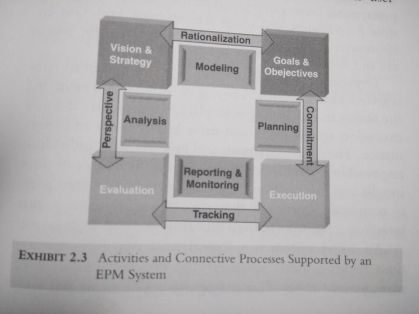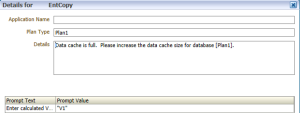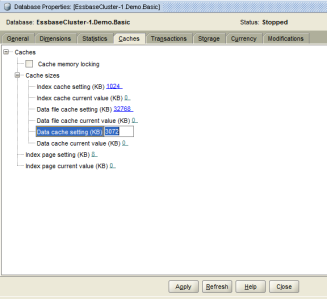Haven’t had a chance to try the new version yet. However still able to experience the new version from EPM Gurus as always:
- http://www.orahyplabs.com/2015/01/11124-released.html
- http://john-goodwin.blogspot.sg/2015/02/planning-11124-new-features.html
- http://camerons-blog-for-essbase-hackers.blogspot.sg/2015/02/taking-11124-for-spin-in-cloud.html
It seems that the new features came out are not as excited as expected. Let wait for the PSU…
All the time people asking me (I believe it happens the same for all EPM consultants out there also)
- “What are you doing?”
- “EPM Consultant.” I answer
- “So you are consultant. But you consult what? It is building construction? Is it network or infrastructure?…”
- “No, it’s EPM. EPM stands for Enterprise Performance Management is an information system that help enterprises manage its performance…..” (this is going to be complicated)
- “Is it all about talking, talking and talking? Is it no coding at all?”….Those kinds of questions
- “No, I’m implementation consultant. I have to do a lot of things….blah blah blah”
It’s really not easy to explain this question at all: What I’m doing or what we, EPM consultant, doing? It even took me for years to fully understand what I’m doing. So I don’t expect a job title or a short job description can answer the question. This entry will do.
Another reason is that I believe it’s very important to fully understand what we are doing. If it’s not for doing our job better, at least it will motivate us to do things more proper. As I tried to search on the internet to find a completed definition for my job but could not found any satisfied result. So l define it myself based on my own experience and all the collective knowledge for the last 5 years working in this industry. Hope it’s worth to share.
I don’t expect everyone will understand this explaination. But since this EPM consultant is an intersection of IT (Information System), Finance and Management, I expect at least those in IT, finance and management will understand or gain some perspectives from this post.
Let break it down to 3 questions?
- What is EPM?
- What is EPM system?
- What is EPM implementation Consultant?
———————–
What is EPM?
EPM stands for Enterprise Performance Management is a set of management and analytic processes that enables the management of an organization’s performance to achieve one or more pre-selected goals (wiki)
You can simply understand it as a subset of management activities in any company/enterprise/organization that mainly focus on or driven by performance of that organization.
Basically, it include 4 activities as a management cycle (as described by the Exhibit below)
- Vision & Strategy
- Goals & Objectives
- Execution
- Evaluation
———————————-
What is EPM system?
From users (finance, management) perspective, an EPM system is an information system or anything related to IT (information technology) that support for the management cycle above by modeling Vision & Strategy to Goals & Objectives, specify all the Goals & Objectives to detail Planning and Budgeting for Execution, support all kind of Reporting & Analysis to track the actual performance for Evaluation as well as monitoring and provide perspectives for enterprise to improve the whole cycle again and again…
An EPM system will help enterprise to Centralize, Unify, Standardize, Synchronize and Automate all the data, processes… related to EPM activities above
Compare to ERP system, ERP system is a system helps organization run their business by standardizing and automating high volume, transactional business processes across an organization. But they do little or nothing to help them manage their business. So you can think of ERP is a based system for running business, EPM is a system running above ERP that’s for manage business effectively. So it’s clear that most of organization implement ERP first then later implement EPM.
For more detail understanding about EPM and EPM system, I highly recommend you read the book “The performance Management Revolution: Business Results through Insight and Action” by “Howard Dresner”. Most of ideas of this post you can also find in this book.
From technical perspective, an EPM system such as Oracle EPM is an enterprise software that provides a platform (framework, product, tool…) specified for EPM purpose. Implementation consulting firm will base on that platform to configure, develop specific system that suits with specific company/enterprise/organization.
Similar to ERP system, but while ERP system is a set of a lot packaged products that already had completely all the functionalities required for business activities. The implementation firm need only to configure the parameters and do customization on the products for the system to be suited with specific organization. EPM system, on the other hand, is usually developed from a scratch based on the provided platform. So usually EPM system will get higher requirement compliance than an ERP system.
An EPM system may be provided by any provider such as Oracle, IBM, SAP, Anaplan… See the full list of vendors here
(As mainly working on Oracle EPM, an typical EPM system and #1 in the market, I will choose it for the explanation)
——————————————————————————–
The next post I will continue with the question: What is EPM implementation Consultant? Or What he actually does? Is there any coding or just talking? What should be the main goals for EPM consultant? What a typical EPM project look like? Why consultant but not developer or anything else?
As I previously reported, there are currently two working EPM code sets in place from Oracle: The Oracle PBCS Cloud code set, and the on premise version. 11.1.2.4 is where they will finally be brought together.
Oracle currently has 150 customers of OPBCS with about 30 of them live. The biggest problem at this point is to keep up with the demand from a hardware perspective, so on-boarding has been a slower process than expected.
The OPBCS will go through one more cloud-only patch in Q4 that will bring in a new interface, mobile capabilities, etc. After that is released and tested in the cloud, Oracle will release the on-premise 11.1.2.4 version that will incorporate all the Cloud functionality plus some additional features. After that, the versions should be released in sync. Once in sync, the on-prem version will have all the performance analytics, self service tutorials, etc.
At Oracle…
View original post 495 more words
As Hyperion Planning application is used for keeping many financial sensitive data, it’s very important for users to audit all the changes made in system.
Fortunately, Hyperion Planning have capability of tracking all (or almost) the changes made in application from data change to metadata, form definition….
How to? Read this tutorial from Oracle: http://www.oracle.com/technetwork/middleware/planning/tutorials/pln-audit-trail-097704.html
However, as you have seen in the tutorial, in order to view it you need to pull these records from Relational database that’s quite inconvenience for users. You can either use OBIEE to create audit report or you may use the workaround below to run a VB Script to create a report from workspace: http://www.orahyplabs.com/2013/12/run-vb-script-in-workspace.html
Check out the new update from Planning guru Cameron about what’s coming in next version of Planning: http://camerons-blog-for-essbase-hackers.blogspot.sg/2014/07/whats-coming-in-planning-11124.html
I’m looking forward to see how these features, especially the client calculation feature capable of. If it works like what it’s said, it would make our life as well our client much more easier.
Originally posted on The I.T. Side
Now with Oracle Cloud EPM, you just need from $120/month/user for at leasts 10 user to have most of Oracle EPM advantages.
—————————————–
Yes you can afford Oracle EPM – how to get started for less.
Let’s face it, implementing Oracle software can be an expensive undertaking. After doing some quick analysis, many companies who desperately want to get out of the spreadsheet rat-race feel over burdened with the perceived high cost implementing an enterprise solution for performance management. No company is adverse to spending money if it will yield a worthwhile return. But if you are new to EPM, getting a handle on the overall ROI with EPM and BI can be challenging.
- What value will the EPM solution bring?
- What cost savings will be realized as a result?
- What quality will be improved?
- What risks will be reduced?
- How much time will be saved?
Of course, the flip side to this is cost.
Let’s break down the major cost factors for an EPM implementation, outline some considerations for each, and identify opportunities to reduce cost.
1.) Software Licensing and support
Most Oracle EPM modules are priced by the number of application users and can be thousands of dollars per user. There is also the cost of support which entitles you to software updates.
Oracle’s pricing list is here
http://www.oracle.com/us/corporate/pricing/price-lists/business-intelligence-price-list-071347.pdf
Considerations:
Oracle EPM software pricing can be done with a suite of products that come with many popular modules and the ability to add on options. You can also purchase each individual product standalone.
The way to save:
- Every product has a minimum number of users you must purchase. Organizations just getting started in EPM could consider the minimum user license for now, you can also add more users later.
- Only buy what you need. Many times the all-in-one suites have many modules you do not need. Perhaps looking at a standalone module would be best to start with and add on as needed.
- Many organizations split the cost between multiple organizational divisions to help reduce the burden to the individual cost centers.
- Implement a phased approach. Implement one module at a time, for a core group of users, then expand.
Where we can help:
We can perform a full assessment of your overall EPM, BI, and reporting vision to assist you in software selection, capabilities, and add-ons you need, identify phases, and ascertain overall cost and ROI. We can also help in your negotiations with Oracle, and even help you write an RFP if you want to send it out for bid.
2.) Hardware
While software licensing costs can be somewhat straight forward, often times hardware costs can be a black box. Understanding all the necessary servers, network equipment, disk storage, required third party software, etc. can be daunting to the point of giving up. However, this information is simply mandatory to adequately cost out your project.
- Operating System cost
- Server cost – based on required CPU, Memory
- Disk Storage
- Required third party software such as Oracle database or SQL Server.
Considerations:
There are many factors that will influence what is required for hardware. The number of environments, users, uptime/availability requirements, and understanding what internal technology that can be leveraged such as pre-existing Storage Area Networks. The only way to know for sure is to have a professional hardware design performed.
The way to save:
- Consider cheaper operating systems, such as Linux.
- Consider virtual machines to lower the physical hardware footprint.
- Only buy what you need. Consider starting with only a DEV and PROD for now.
How we can help:
We perform a standard one-day hardware design session with your organization to completely understand the use case, modules, scalability, security needs, service level needs, etc. It is a very quick and inexpensive offering that can prevent a lot of budget surprises.
Still too expensive? Have us deal with it for you.
We also offers Oracle EPM and BI server hosting. Using our cloud hosted services, organizations save big time by eliminating the large cost of servers (That have to be replaced every few years). Also eliminated is the infrastructure space, electricity, etc. Our hosting service provides:
- Secure high-speed access to servers over secure VPN – the servers look like they are directly on your network, so data integration is a snap.
- Full high-availability fault tolerance.
- Full data center disaster recovery with geo-redundant storage.
3.) Software development and training
The possibilities with the Oracle EPM stack are seemingly infinite. However, it has to be developed. The installation creates a blank canvas and it needs to be developed and configured which takes time, money, and know-how.
Considerations:
Even the smallest greenfield implementation will undergo these major steps:
1.) Design/AssessmentDimensionality, reporting, data integration, etc.2.) ImplementationConfigure the software to the design
3.) Testing
Conference Room Pilots, User Acceptance Testing, etc.
4.) Training, documentation
User and Admin training
5.) Roll-out
Go-live, parallel close cycles,
6.) Expand
Adding additional functionally, users, divisional units, detail, modules, etc.
The way to save:
- Implement a phased approach. Start with one module, one application, and simple reports. Go-live and get user acceptance, then expand capabilities.
- Use an implementation partner to train your people so that they can continue with the application development, reports, etc.
How we can help:
We have dedicated rapid deployment programs specifically for midsize companies seeking to get up and running fast. We have fast tracks for rapidly deploying Business Intelligence (OBIEE), Planning, Financial Management, and Data Relationship Management. This program is perfect for those that want start their journey away from Excel and embrace an enterprise solution as a quick win first step. The scope is clear, implementation is quick, with detailed training and documentation throughout.
4.) Ongoing administration, support.
Just like all enterprise system, this is not a set-it-and-forget-it solution. Oracle EPM requires ongoing administration and support both functionally and from IT.
- Data and metadata loading
- Calculations, aggregations, consolidations
- User access issues
- Server maintenance and troubleshooting
- Backups
- Patching
- Monitoring
Considerations:
This typically involves many people. While it may not be a full time job for any one individual, it does involve many skill sets. Functional admin users are usually the first line of support for issues. Technical issues could easily involve server admins, database admins, network admins, etc. Most importantly, someone needs to create, maintain, monitor, and test backups and recovery procedures.
The way to save:
Ensure you are working with a partner that takes administration and IT training seriously. Properly spending time training admins up front will significantly save time and money in the long run.
How we can help:
We offer all sorts of training including administration training and dedicated IT training covering proper maintenance, troubleshooting, logging, backup/recovery, architecture, scalability, tuning, etc.
If you are understaffed – have no fear. No need to go out and hire full time people, we offer worry-free Managed Services and Helpdesk services for companies of all sizes. For midsize companies getting started in EPM, we offer a low-cost basic package for Helpdesk services; including a fully functional web based ticketing system and 15 minute service-level ticket acknowledgment from our knowledgeable on-shore Helpdesk team. This service can save you 60-70% in overall costs associated with day to day maintenance and support costs. For companies wanting more IT services, our fast reacting helpdesk can do ongoing proactive health monitoring, job monitoring, backups, tuning, patching, etc.
Summary
It’s obvious that there many possibilities to implement EPM. Whether you are looking start a new EPM project, reduce costs of your current implementation, upgrade, improve support, etc…. it all starts with discovery workshop. We will help you justify your ROI, calculate costs, and go over all your options to ensure you are not overbuying, over allocating, or inaccurately budgeting.
It is possible to start your journey to EPM on almost any budget. Contact me for more information on how to get started.
New Oracle EPM Infographic…
Posted on: June 26, 2014
So Cloud, mobility, big data leverage are the most popular trends for 2014
Everyone should see yourself on this 😀
All about Essbase Data Cache
Posted on: June 16, 2014
If you have already been a Hyperion Planning consultant long enough, you should have met this issue sometimes: “Data cache is full. Please increase the data cache size for database…”
Of course our first thought to solve this problem is to increase the data cache size for database like what the instruction said. And below is how:
OK, but how much the data cache should be for best practice? You can read this http://docs.oracle.com/cd/E12825_01/epm.111/esb_dbag/dstcache.htm#dstcache1010002
By default, it’s just 3072 KB. So if you keep increasing the cache but you still have this issue, it’s time for you to think about your business rule or even your design. Because the more memory you allocate for data cache, the more RAM essbase will take over permanently (never release even the rule has already finished) unless you restart the Essbase app/cube.
Once Essbase pulls a block into memory, it won’t release it unless the app is stopped, or there is no additional memory available, and it has to release the block so it can go get another block. So Essbase won’t really “release” the memory. This is one reason Essbase has a reputation for not playing nicely with other applications on the same server (like relational databases).
http://www.network54.com/Forum/58296/thread/1167930858/Releasing+memory
What need a lot of Data Cache usually are those calculation need the participating of a lot of member/data such as aggregation. For example:
FIX (Year1, Year2, Year3)
CALC DIM (Entity, Product, Customer, Currency, Period).
// To aggregate the parent, it’s needed to load all the children to Cache to perform the aggregation
ENDFIX
The above rule aggregates most of dimensions so it may need the whole cube load into Cache to perform calculation. To solve this issue either you can try to break the rule in to parts:
FIX(Year1)
CALC DIM (Entity, Product, Customer, Currency, Period).
ENDFIX
FIX(Year2)
CALC DIM (Entity, Product, Customer, Currency, Period).
ENDFIX
…
Or thinking about a way to make your block size smaller…. depend on specific situation.





Recent Comments